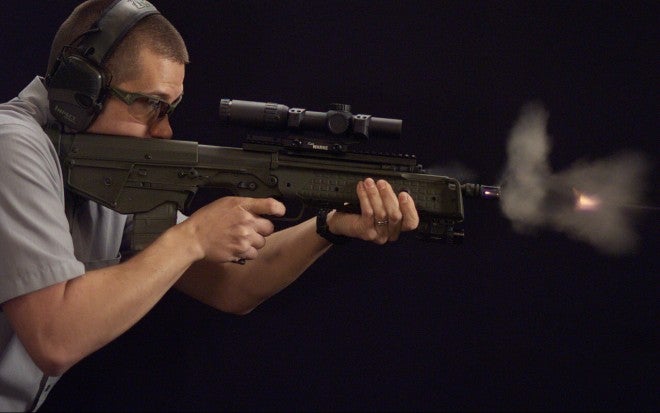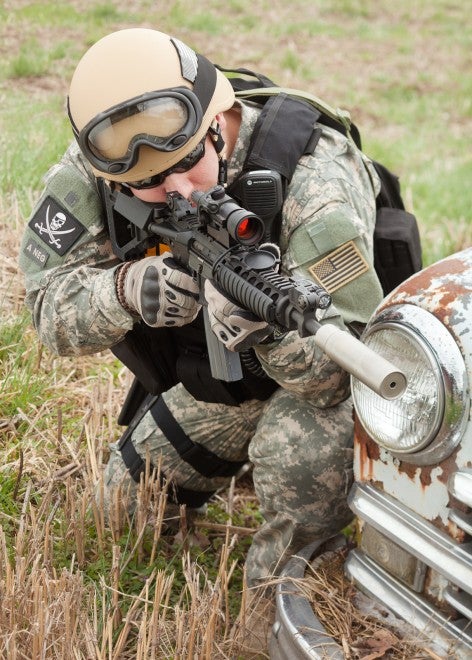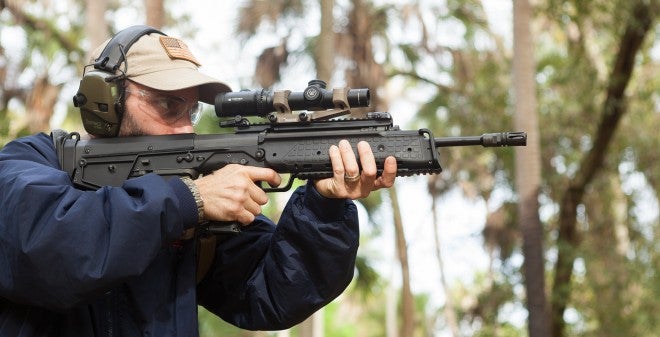Shorter Barrels for Defensive Rifles
Oleg Volk 03.29.15

The original AR15 was designed around iron sights and a lightweight, high-velocity bullet. 55-grain M193 ball gave flat trajectory and reliably fragmented in flesh at velocities above 2700fps. With the proliferation of flattop rifles and optical sights, the sight radius becomes a consideration mainly for backup use. For the original barrel length, that included ranges up to 200 yards. The shortest barrel for civilian use that is not restricted by NFA1934 is 16 inches, yielding about 150fps lower initial velocity and reducing the fragmentation range to 150 yards. The shortest non-NFA AR in common use has a 14.5″ barrel with a permanently attached muzzle devices extending the length past 16″. Its fragmentation range is closer to 50 yards. With the heavier 62-grain M855 load, these numbers are further reduced. How relevant is this loss of velocity to our use?
For hunting, most people use either soft point or ballistic tip hollow point bullets. They have different expansion velocity requirements, but usually do better from long barrels due to the ranges at which game or varmints are taken. Flatter trajectory is the other benefit of higher velocity, and adding more length is usually not weigh-prohibitive with the tapered sporter barrel profiles.
The main focus of the barrel length argument is in the defensive application. Very few defensive shootings happen at ranges longer than 50 yards, for which even the 14.5″ barrel provides sufficient velocity. A lot of defensive shootings happen either indoors or around vehicles, both of which favor the more compact form factor. The main argument for effectiveness seems to center on the ammunition choice. If Milspec ball is used for both training and social work, then the barrel length matters considerably, not in the least due to over-penetration concerns. If, like most of the people I observe, the cheapest available commercial or surplus ball is used for training but more sophisticated expanding or fragmenting ammunition is reserved for defense, then the barrel length becomes less relevant to performance. For example, my tests on all-copper 5.56mm expanding ammunition showed excellent performance even from a 12.5″ barrel.

So factors other than effectiveness with military ball may have to come into play: balance and handiness, muzzle blast/flash, and cycling reliability. Cycling issues for shorter weapons can be addressed with variable gas blocks or muzzle devices that increase back-pressure. Sound suppressors have that side effect as well, and usually shorter barrels really help with the balance for those.

For most of us, shorter weapons remain un-suppressed, with unmitigated muzzle blast even more severe than from full-length rifles. On the plus side, a 14.5″ barreled AR15 can be handled with one hand if necessary, which is a harder feat with the full-length variant.

What about bullpups? Centrally balanced, they handle about as well with a 20″ barrel as with 16″. Tavor can be had with 16.5″ and 18″ tubes, the upcoming RDB with 17.3″ and 20″. The velocity difference between the two RDB variants is about 80-160fps for different 55-grain loads. The difference in weight is under 6 ounces, and the balance is similar. The reduction in muzzle blast is perceptible but not huge. For suppressed use, the choice is clearly the shorter variant. Heavier bullets lose proportionally less velocity, while the two-pound suppressor balances best closer to the shooter. But what about un-suppressed defensive use? Is there a compelling reason to go with the longer barrel over the shorter one?